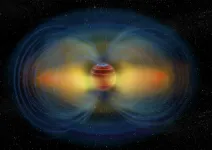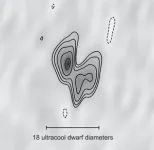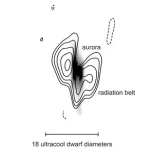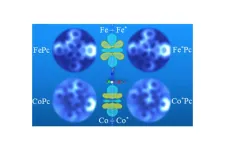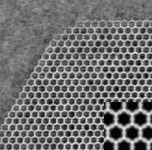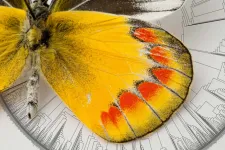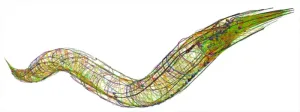(Press-News.org) Astronomers have described the first radiation belt observed outside our solar system, using a coordinated array of 39 radio dishes from Hawaii to Germany to obtain high-resolution images. The images of persistent, intense radio emissions from an ultracool dwarf reveal the presence of a cloud of high-energy electrons trapped in the object’s powerful magnetic field, forming a double-lobed structure analogous to radio images of Jupiter’s radiation belts.
“We are actually imaging the magnetosphere of our target by observing the radio-emitting plasma—its radiation belt—in the magnetosphere. That has never been done before for something the size of a gas giant planet outside of our solar system,” said Melodie Kao, a postdoctoral fellow at UC Santa Cruz and first author of a paper on the new findings published May 15 in Nature.
Strong magnetic fields form a “magnetic bubble” around a planet called a magnetosphere, which can trap and accelerate particles to near the speed of light. All the planets in our solar system that have such magnetic fields, including Earth, as well as Jupiter and the other giant planets, have radiation belts consisting of these high-energy charged particles trapped by the planet’s magnetic field.
Earth’s radiation belts, known as the Van Allen belts, are large donut-shaped zones of high-energy particles captured from solar winds by the magnetic field. Most of the particles in Jupiter’s belts are from volcanoes on its moon Io. If you could put them side by side, the radiation belt that Kao and her team have imaged would be 10 million times brighter than Jupiter’s.
Particles deflected by the magnetic field toward the poles generate auroras (“northern lights”) when they interact with the atmosphere, and Kao’s team also obtained the first image capable of differentiating between the location of an object’s aurora and its radiation belts outside our solar system.
The ultracool dwarf imaged in this study straddles the boundary between low-mass stars and massive brown dwarfs. “While the formation of stars and planets can be different, the physics inside of them can be very similar in that mushy part of the mass continuum connecting low-mass stars to brown dwarfs and gas giant planets,” Kao explained.
Characterizing the strength and shape of the magnetic fields of this class of objects is largely uncharted terrain, she said. Using their theoretical understanding of these systems and numerical models, planetary scientists can predict the strength and shape of a planet’s magnetic field, but they haven’t had a good way to easily test those predictions.
“Auroras can be used to measure the strength of the magnetic field, but not the shape. We designed this experiment to showcase a method for assessing the shapes of magnetic fields on brown dwarfs and eventually exoplanets,” Kao said.
The strength and shape of the magnetic field can be an important factor in determining a planet’s habitability. “When we’re thinking about the habitability of exoplanets, the role of their magnetic fields in maintaining a stable environment is something to consider in addition to things like the atmosphere and climate,” Kao said.
To generate a magnetic field, a planet’s interior must be hot enough to have electrically conducting fluids, which in the case of Earth is the molten iron in its core. In Jupiter, the conducting fluid is hydrogen under so much pressure it becomes metallic. Metallic hydrogen probably also generates magnetic fields in brown dwarfs, Kao said, while in the interiors of stars the conducting fluid is ionized hydrogen.
The ultracool dwarf known as LSR J1835+3259 was the only object Kao felt confident would yield the high-quality data needed to resolve its radiation belts.
“Now that we’ve established that this particular kind of steady-state, low-level radio emission traces radiation belts in the large-scale magnetic fields of these objects, when we see that kind of emission from brown dwarfs—and eventually from gas giant exoplanets—we can more confidently say they probably have a big magnetic field, even if our telescope isn’t big enough to see the shape of it,” Kao said, adding that she is looking forward to when the Next Generation Very Large Array, currently being planned by the National Radio Astronomy Observatory (NRAO), can image many more extrasolar radiation belts.
“This is a critical first step in finding many more such objects and honing our skills to search for smaller and smaller magnetospheres, eventually enabling us to study those of potentially habitable, Earth-size planets,” said coauthor Evgenya Shkolnik at Arizona State University, who has been studying the magnetic fields and habitability of planets for many years.
The team used the High Sensitivity Array, consisting of 39 radio dishes coordinated by the NRAO in the United States and the Effelsberg radio telescope operated by the Max Planck Institute for Radio Astronomy in Germany.
“By combining radio dishes from across the world, we can make incredibly high-resolution images to see things no one has ever seen before. Our image is comparable to reading the top row of an eye chart in California while standing in Washington, D.C.,” said coauthor Jackie Villadsen at Bucknell University.
Kao emphasized that this discovery was a true team effort, relying heavily on the observational expertise of co-first author Amy Mioduszewski at NRAO in planning the study and analyzing the data, as well as the multiwavelength stellar flare expertise of Villadsen and Shkolnik. This work was supported by NASA and the Heising-Simons Foundation.
END
Astronomers observe the first radiation belt seen outside of our solar system
High-resolution imaging of radio emissions from an ultracool dwarf show a double-lobed structure like the radiation belts of Jupiter
2023-05-15
ELSE PRESS RELEASES FROM THIS DATE:
New study reveals widespread presence of environmental DNA in the sky, including allergens and pathogens
2023-05-15
Recently published in PeerJ Life and Environment, researchers successfully use aircraft surveys with novel instrumentation to capture airborne nucleic acids and probe biodiversity in the atmosphere, uncovering surprising findings.
[Clemson, May 2023] - A groundbreaking research article titled "Aircraft Surveys for Air eDNA: Probing Biodiversity in the Sky" unveils a revolutionary approach to studying genetic material in the atmosphere. Scientists have developed a durable and sterilizable probe and supporting system to capture air environmental nucleic acids (eDNA) with full-flow filtration and a high-integrity chamber.
Using this innovative probe, ...
Tetris reveals how people respond to unfair AI
2023-05-15
ITHACA, N.Y. – A Cornell University-led experiment in which two people play a modified version of Tetris revealed that players who get fewer turns perceived the other player as less likable, regardless of whether a person or an algorithm allocated the turns.
Most studies on algorithmic fairness focus on the algorithm or the decision itself, but researchers sought to explore the relationships among the people affected by the decisions.
“We are starting to see a lot of situations in which AI makes decisions on how resources should be distributed among people,” ...
Distinct types of cerebellar neurons control motor and social behaviors
2023-05-15
The cerebellum, a major part of the hindbrain in all vertebrates, is important for motor coordination, language acquisition, and regulating social and emotional behaviors. A study led by Dr. Roy Sillitoe, professor of Pathology and Neuroscience at Baylor College of Medicine and investigator at the Jan and Dan Duncan Neurological Research Institute (Duncan NRI) at Texas Children’s Hospital, shows two distinct types of cerebellar neurons differentially regulate motor and non-motor behaviors during development and in adulthood.
The study, published in Nature Communications, provides the first in ...
Seeing electron orbital signatures
2023-05-15
No one will ever be able to see a purely mathematical construct such as a perfect sphere. But now, scientists using supercomputer simulations and atomic resolution microscopes have imaged the signatures of electron orbitals, which are defined by mathematical equations of quantum mechanics and predict where an atom’s electron is most likely to be.
Scientists at UT Austin, Princeton University, and ExxonMobil have directly observed the signatures of electron orbitals in two different transition-metal atoms, iron (Fe) and cobalt ...
Commercial investors shift perspective of coastal properties in face of climate change
2023-05-15
UNIVERSITY PARK, Pa. — Investors in commercial real estate are rethinking the values of coastal properties exposed to flood risk — even in northern U.S. locales that haven’t suffered flood damage, according to researchers. This shift in perspective has implications for investors and developers alike as they determine the value of coastal properties amid a changing climate.
Eva Steiner, associate professor of real estate and King Family Early Career Professor in Real Estate in the Penn State Smeal College of Business, and her co-authors published these findings recently in Real Estate Economics.
Steiner and ...
Luo to receive NSF funding for collaborative research: catholyte molecular design for non-aqueous mg-organic hybrid redox flow batteries
2023-05-15
Chao Luo, Assistant Professor, Chemistry and Biochemistry, is set to receive funding from the National Science Foundation for the project: "Collaborative Research: Catholyte Molecular Design For Non-Aqueous Mg-Organic Hybrid Redox Flow Batteries."
Luo is proposing a new organic molecule structure design concept for redox flow batteries, which are promising for grid-scale energy storage. The research outcomes will afford low-cost, abundant, sustainable, and high-performance organic catholyte materials for non-aqueous Mg-organic hybrid redox flow batteries.
His goal is to design, synthesize, and characterize core-shell ...
Huneke wins grant to research lesbians in the Third Reich
2023-05-15
Samuel Clowes Huneke, Assistant Professor, History and Art History, has been awarded a Sharon Abramson Research Grant from the Holocaust Educational Foundation of Northwestern University. The award will enable him to complete research for his forthcoming book on lesbians in Nazi Germany.
For many decades after the end of World War II, the fates of queer women were ignored. Because female homosexuality had not been criminalized explicitly, historians long argued that lesbians were not persecuted by the Nazi regime.
In contrast, Huneke’s book, which is under advanced contract with Aevo-University of Toronto Press, argues that queer women under Nazism faced ...
Porous crystals made from plant extracts purify water from pharmaceutical pollutants
2023-05-15
Researchers from Stockholm University have developed porous crystals made from pomegranate extract to capture and degrade pharmaceutical molecules found in local municipal wastewater. The research is published in the scientific journal Nature Water.
Pharmaceutical compounds affect the human body to improve our health, but they can also have unintentional adverse effects for the wellbeing of wildlife. Hence wastewater treatment plants are facing the challenge of removing emerging organic contaminants (EOCs) such as active pharmaceutical ingredients, and therefore ...
Butterfly tree of life reveals an origin in North America
2023-05-15
About 100 million years ago, a group of trendsetting moths started flying during the day rather than at night, taking advantage of nectar-rich flowers that had co-evolved with bees. This single event led to the evolution of all butterflies.
Scientists have known the precise timing of this event since 2019, when a large-scale analysis of DNA discounted an earlier hypothesis that pressure from bats prompted the evolution of butterflies after the extinction of dinosaurs.
Now, scientists have discovered where the first butterflies originated ...
From molecular to whole-brain scale in a simple animal, study reveals serotonin’s effects
2023-05-15
Because serotonin is one of the primary chemicals the brain uses to influence mood and behavior, it is also the most common target of psychiatric drugs. To improve those drugs and to invent better ones, scientists need to know much more about how the molecule affects brain cells and circuits both in health and amid disease. In a new study, researchers at The Picower Institute for Learning and Memory at MIT working in a simple animal model present a comprehensive accounting of how serotonin affects behavior from the scale of individual molecules all the way to the animal’s whole brain.
“There have been major challenges ...
LAST 30 PRESS RELEASES:
Research validates laboratory model for studying high-grade serous ovarian cancer
SIR 2026 delivers transformative breakthroughs in minimally invasive medicine to improve patient care
Stem Cell Reports most downloaded papers of 2025 highlight the breadth and impact of stem cell research
Oxford-led study estimates NHS spends around 3% of its primary and secondary care budget on the health impacts of heat and cold in England
A researcher’s long quest leads to a smart composite breakthrough
Urban wild bees act as “microbial sensors” of city health.
New study finds where you live affects recovery after a hip fracture
Forecasting the impact of fully automated vehicle adoption on US road traffic injuries
Alcohol-related hospitalizations from 2016 to 2022
Semaglutide and hospitalizations in patients with obesity and established cardiovascular disease
Researchers ‘listen in’ to embryo-mother interactions during implantation using a culture system replicating the womb lining
How changing your diet could help save the world
How to make AI truly scalable and reliable for real-time traffic assignment?
Beyond fragmented markets: A new framework for efficient and stable ride-pooling
Can shape priors make road perception more reliable for autonomous driving?
AI tracks nearly 100 years of aging research, revealing key trends and gaps
Innovative techniques enable Italy’s first imaging of individual trapped atoms
KIER successfully develops Korea-made “calibration thermoelectric module” for measuring thermoelectric device performance
Diversifying US Midwest farming for stability and resilience
Emphasizing immigrants’ deservingness shifts attitudes
Japanese eels, climate change, and river temperature
Pusan National University researchers discover faster, smarter heat treatment for lightweight magnesium metals
China’s 2024 Gastroenterology Report: marked progress in endoscopy quality and disease management
Pusan National University researchers uncover scalable method for ultrahigh-resolution quantum dot displays
Researchers use robotics to find potential new antibiotic among hundreds of metal complexes
Gut bacteria changes at the earliest stages of inflammatory bowel disease
Scientists develop new way to “listen in” on the brain’s hidden language
Brain research: “Pulse generators” grow and shrink as memories are formed
For teens, any cannabis use may have impact on emotional health, academic performance
School meals could unlock major gains for human and planetary health
[Press-News.org] Astronomers observe the first radiation belt seen outside of our solar systemHigh-resolution imaging of radio emissions from an ultracool dwarf show a double-lobed structure like the radiation belts of Jupiter
